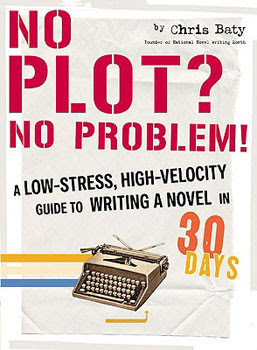If it's November it must be National Novel Writing Month (NaNoWriMo). Chris Baty is credited with creating or at least promoting the effort to draft a 50,000-word novel in thirty days. Lots of folks daydream about writing a novel and seeing their book on the shelf at a bookstore or in the library. But daydreaming is a far cry from actually writing. And it is off putting when we hear stories about people spending years writing and editing a novel -- so most wanna be authors move on with their real lives and never write that book.
Baty determined that, "The biggest thing separating people from their artistic ambitions is not a lack of talent. It's the lack of a deadline." Hey, if a deadline works for cleaning the house before guests arrive, why can't it work for a novel?!
Andi Erickson recently presented a workshop on "How to Write a Novel in 30 Days" for the Wilsonville Library's Dewey Speaks series. A previous winner of NaNoWriMo, Ms. Erickson summarized the effort in three simple steps:
- Have something to write with,
- Have a plan,
- Write.
Okay. See ya!
Of course, there's more to it than that. As we learn in all novel-writing workshops, good fiction is about conflict. The main character has a want and there is an obstacle to that want. Publishable novels require a plot, defined as conflict + action + resolution. Plot is developed around a basic structure, the classic being the three act format:
- Act I = set up the conflict (beginning),
- Act II = conflict and escalation of conflict (middle),
- Act III = resolve the conflict (end).
There are a variety of approaches to developing a publishable novel and Ms. Erickson emphasized that no one method works for all writers. Find what works for you and run with it. But she summarized plot development questions that pretty much work no matter how one goes about creating a long work of fiction.
- Who wants what?
- What gets in his/her way?
- What does she/he do about it?
- What is the result?
These questions not only work in developing the entire story arc, but also apply to each scene.
Wants _____ but _____ so _____ and then _____ ... but then _____.
The character has a desire, but there is an obstacle to obtaining that desire, so the character acts, and then there is a result of that action. We are carried into the next scene with "but then...."
At the resolution of the novel the goal is obtained, or the attempt fails, or the goal is reached but it turns out not to be what the character really wanted, or the character fails but it turns out to be okay.
Ms. Erickson drew from her own experience plus Baty's book to provide various aids to help writers through the four week effort. But what I scribbled on a sticky note that I have applied to the front of my Mac was the scene/story arc summary. Even though I've heard it before (or variations), it takes several times before it sinks in. I can only absorb so much at each workshop I attend or from each book I read about creating fiction.
Most comforting is the reminder that a first draft (no matter how long it takes to complete) is not expected to be good. Per Baty, Ernest Hemingway said "The first draft of anything is shit." I've even heard and read of writers who label it "shitty first draft" to give them the freedom to write without interference from the inner editor.
So, if it's November (or any time you choose), write often, write fast, just write.

1 comment:
Oh man, you really gave me a kick in the britches didn't you? You are so right, I should just write.
I now see that this post was a sign to me, as the "word verification" word is my Grandfathers name..... wow
Post a Comment